本文
外国語 英語
Outline of Okayama Prefectural Museum
Okayama Prefecture (former Kibi Province),as well as the northern Kyūshū region and the Kinki area, had become civilized in ancient times. Therefore, plenty of cultural properties still remain.
This museum was established and opened in 1971 as a historical museum for collection and preservation of cultural heritage (from primitive and ancient through recent times), planned as a part of the 100th anniversary celebrations of Okayama Prefecture. The aim is to hand down the cultural heritage to posterity, and to exhibit its representative examples.
Guide of Exhibits
Archaeology
In the section of the Paleolithic period, there are relics from the time that humankind became active in Japan Islands such as stoneware discovered at the mountainous region of the Chūgoku District; fossils of a Naumann elephant that were caught in a fishing net on the Seto Inland Sea Coast.
The section of the Jōmon period exhibits the relics found from Nakatsu and Fukuda kitchen middens that show the life and culture at the time such as earthenware and flint arrows.
In the section of the Yayoi period, there are bronze bell-shaped vessels and swords, and special utensil stands which advanced peculiarly at Kibi Area on exhibition.
The section of the Kofun period exhibits valuable excavated articles such as Sankaku-buchi Shinjūkyō mirrors (bronze mirror with decorations), golden earrings, and Decorated Sueki Jar discovered from Kofun (ancient burial mounds) and so on.
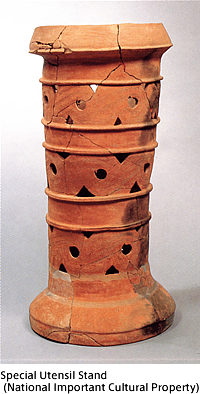
Documents
According to the documents relating to Ushimado Honrenji Temple and Saidaiji Temple, it is noted that markets were founded and ports were prospered in the Middle Ages because of the productivity improvement. Also, documents which showed power balance of samurai groups such as a written edict of Ashikaga Takauji and Akamatsu are exhibited.
The museum exhibits old historical documents including Bizen Ichinomiya Shrine ritual picture scrolls and the Nichiren sect papers that show the expansion of religious faith and culture here in the medieval times. The letters of warlords are exhibited in the section of the Warring States period.
The section of the modern ages exhibits colorful maps of provinces and villages, as well as calligraphy of the clan leaders and servants. Also, documents of Rangaku (Western studies) initiated by Udagawa and Mitsukuri families, and calligraphy of modern poets, writers and scholars represented by Gyokudō, Ryōkan, Jakugon and Motoyoshi are exhibited.
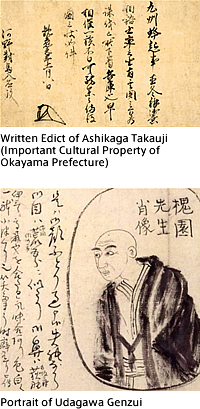
Arts and Crafts
Exhibited here are excellent articles of sculpture, paintings and craftworks that lead to the current Okayama culture. The articles lineups in the age of ancient and middle consist of masterpieces of Buddhist art.
Various figures of Buddha and Buddhist paintings which symbolize the period of Heian, Kamakura and Muromachi are designated as important national or prefectural cultural properties. Buddhist altar fittings like Gokorei (five-pronged vajra with suzu gong) and Keman (openwork decorating a chain of beautiful flowers, hanging ornament), and a piece of illustrated handscroll showing Honen Shonin’s whole life, (who was born in Okayama and became the Jōdo sect founder.) are also exhibited.
From among the works in the early Modern Ages, Birds and Flowers panel paintings of Nobuharu(Tohaku) Hasegawa and some of other schools are on display. Works of Okayama-born and nationwide painters such as Uragami Gyokudō and his son Shunkin, Hirose Daizan, Fujimoto Tesseki (Nanga school), Okamoto Toyohiko and Shibata Gitō (Shijō school) are mainly exhibited at the late Edo period section. In addition, various votive pictures dedicated to the temple and shrine are exhibited.
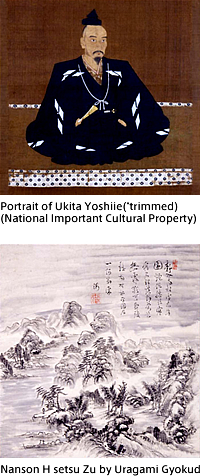
Folklore
The transition of the life of the ordinary people can be traced by seeing the exhibited various folklore data of each theme in this corner. A Takase boat that bore the river traffic, a paving net fishing implement (important prefectural tangible folk-cultural asset ) which is peculiar to the Kojima bay, and Kinkan-en loom by Isozaki Minki, the wood coordinator Kijishi’s tool, the carpenter's tool and the farming tool, etc. have been exhibited. Old work tools and daily life tools are called the folklore data. To our regret, the folklore data is disappearing because of a drastic change in the postwar society.
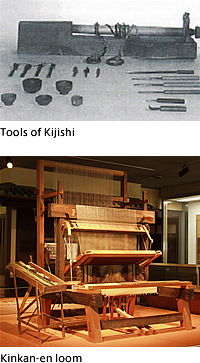
Swords and Armor
The production of iron flourished in the Country of Kibi (ancient Okayama), and a number of swords were unearthed from ancient tombs. All those swords called “Taira-zukuri” or “Kiriha-zukuri” were straight without curved blades.
In the Heian period, however, swords with Shinogi, the ridges on the sides of a sword blade, and curved blades emerged. Bizen and Bitchū are known as the most famous places for sword making. In Bizen, Kanehira, Tomonari,and Masatsune were representative swordsmiths, and Yasutsugu and Moritsugu were famous in Bitchū.
In the Kamakura period, there were several schools such as Ichimonji, Osafune, Hatada, Ugai, Aoe and so forth, and the artisans continued to make eminent swords. We have collected those swords from Bizen and Bitchū areas and exhibited them in this museum.
In addition to those swords, the museum has Akagawa-odoshi Ōyoroi (armor with red leather lacing; National Treasure) from the late Heian period, and Murasaki-ito-odoshi Haramaki (armor laced with purple cords; Important Cultural Property of Okayama Prefecture).
They have been occasionally exhibited with deposited Iroiro-odoshi Ōyoroi (armor laced with various color cords; Important Cultural Property, Toyohara-kitashima Shrine), Kon’ito-odoshi Katashiro Haramaki (armor laced with navy cords; Important Cultural Property, Henmyōin Temple), Kurogawa-odoshi Ōyoroi (armor with black leather lacing; Important Cultural Property of Okayama Prefecture, Gokōgū Shrine) of the Nambokuchō period.
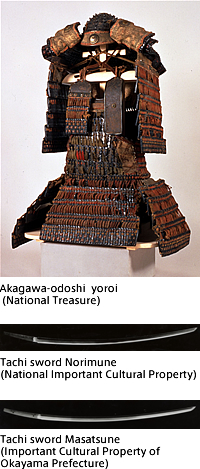
Bizen Pottery
Bizen pottery, the traditional craft product that represents Okayama Prefecture, dates back to the Asuka and Hakuhō periods from Sabukazekoyō (ruins in the northeastern part of Okayama).
From the Kamakura period to the mid-Muromachi period, various ceramics such as mortars, pots,and jars were made. They gradually came to dominate the market in the western Japan. In addition, tea utensils were made along with the increasing popularity of tea ceremony in the late Muromachi period. This was because Bizen pottery tea utensils seemed to be in harmony with Wabi mentality which formed an important basis of the traditional tea ceremony.
The museum exhibits a variety of daily ceramics such as pots, jars, mortars, large dishes and large sake bottles whose dates are identified. Furthermore, tea utensils such as Chaire (container for tea leaves), jugs, Kensui (pot used in order to clean tea cups), vases, pots and sake bottles, mainly from the Momoyama period, are exhibited.
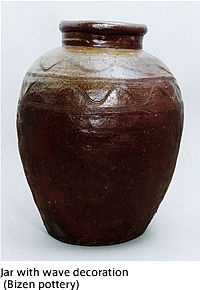
Admissions
| Fees | Classification | General | Groups of 30 or more (20% discount) |
|---|---|---|---|
| Adults | 260 yen | 210 yen | |
| Seniors (65 and over) |
130 yen | 100 yen | |
| Free for Students under High School | |||
| ※ Special exhibitions require a separate admission fee. | |||
| Free Admission |
|
||
- Wheelchairs and baby strollers are available, free of charge.
- A guided tour led by a Museum lecturer is a wonderful way to enhance your group's visit. Museum-guided tours must be reserved in advance.
Access
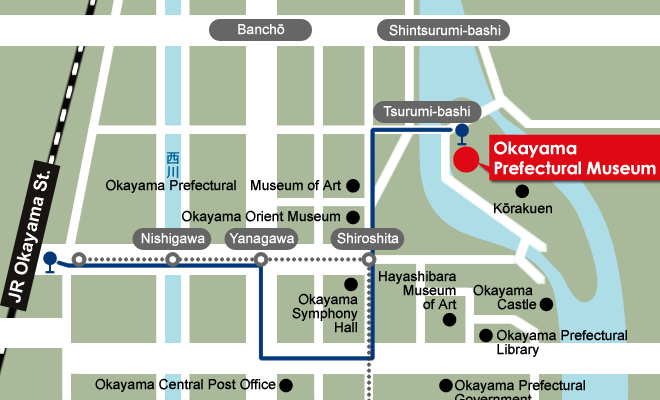
- 15min. by car from Okayama IC San’yō Expressway
- 25min. on foot from JR Okayama St.
 10min. on foot from the Shiroshita stop on the tram bound for Higashiyama (Line 1) about 5 min.
10min. on foot from the Shiroshita stop on the tram bound for Higashiyama (Line 1) about 5 min. Next to the Kōrakuen-Mae stop on the city bus [Okaden bus] bound for Fujiwara Danchi. About 20 min. ride from Okayama St. Bus Terminal.
Next to the Kōrakuen-Mae stop on the city bus [Okaden bus] bound for Fujiwara Danchi. About 20 min. ride from Okayama St. Bus Terminal.
